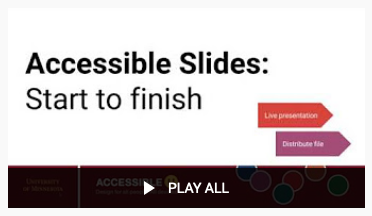In this Issue: Accessibility and Remote Teaching
-
- Ensuring equitable accessibility in your remote course
- Creating accessible slide presentations
- Video captioning
- USask AES – Instructor guide for accommodating students with disabilities
- DEU support and contact information
Ensuring equitable accessibility in your remote course
![]() In your rush to get course materials ready and online for this remote teaching term it’s possible that accessibility was not at the front of your mind. But for some students, the inability to access campus spaces and resources may actually increase the impact their disability has on their academic performance. It is important that faculty members and instructors consider ways to expand the modalities of course delivery that they are using; doing so will not only make your courses more accessible and equitable, but will improve the learning experience for all of your students. This is the basis of what is called Universal Design for Learning.
In your rush to get course materials ready and online for this remote teaching term it’s possible that accessibility was not at the front of your mind. But for some students, the inability to access campus spaces and resources may actually increase the impact their disability has on their academic performance. It is important that faculty members and instructors consider ways to expand the modalities of course delivery that they are using; doing so will not only make your courses more accessible and equitable, but will improve the learning experience for all of your students. This is the basis of what is called Universal Design for Learning.
Explore the links below for some simple ways you can check and improve the accessibility of your course materials.
Canvas – Beginner’s Accessibility with the Rich Content Editor
Canvas – General Accessibility Design Guidelines
Accessibility Features in Blackboard Learn
BCcampus Accessibility Toolkit – Free e-Book
Ryerson University’s Sa11y accessibility quality assurance assistant
Creating accessible slide presentations
Accessible U has a great series of videos on creating and giving accessible slide presentations.
Visit the video playlist on creating accessible slide presentations.
Video captioning
 Many instructors have created short lecture videos for their remote course this fall. Video has it’s own challenges when it comes to remaining accessible for all students. The Web Content Accessibility Guidelines, also known as the WCAG standard, provides a 3 level approach to accessible online video.
Many instructors have created short lecture videos for their remote course this fall. Video has it’s own challenges when it comes to remaining accessible for all students. The Web Content Accessibility Guidelines, also known as the WCAG standard, provides a 3 level approach to accessible online video.
WCAG Compliance Levels for Online Video:
-
- Level A: Captions are provided for all prerecorded audio content in synchronized media, except when the media is a media alternative for text and is clearly labeled as such.
- Level AA: In addition to Level A compliance, captions are provided for all live audio content in synchronized media.
- Level AAA: In addition to Levels A and AA compliance, sign language interpretation is provided for all prerecorded audio content in synchronized media.
Adding captions to your course videos can improve the learning experience for all of your students. Research shows that roughly 90 percent of all students who use closed captions find them at least moderately helpful for learning. There are two ways to add captions to your pre-recorded Panopto videos, Machine-generated captions (which may require some minor editing for corrections) and Human-generated captions. 
Find out more about Panopto video captioning
PowerPoint for Microsoft 365 can transcribe your words as you present and display them on-screen as captions in the same language you are speaking, or as subtitles translated to another language. This can help accommodate individuals in the audience who may be deaf or hard of hearing, or more familiar with another language, respectively.
Present with real-time, automatic captions or subtitles in PowerPoint
USask AES – Instructor guide for accommodating students with disabilities
Access and Equity Services at the University of Saskatchewan has a great Instructor Guide that can help you understand student accomodations for remote learning. The guide provides valuable tips for designing accessible content and assessments for students, informs you about some of the assistive technologies available and provides additional support opportunities.
Explore the instructor guide for accommodating students with disabilities



